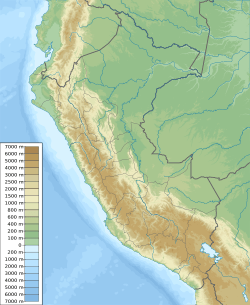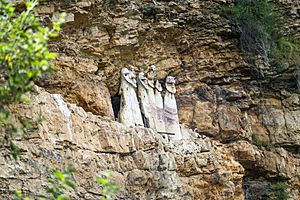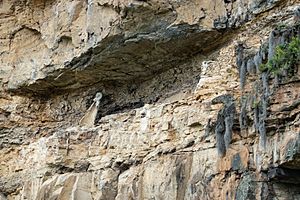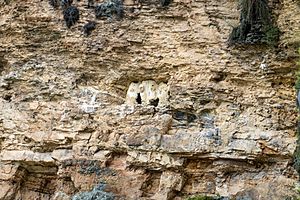Sarcophagi of Carajía facts for kids
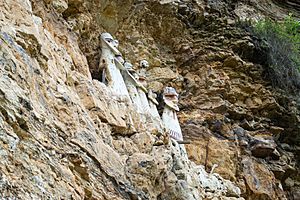
Sarcófagos de Karajía
|
|
| Location | |
|---|---|
| Coordinates | 6°09′43″S 78°01′17″W / 6.16194°S 78.02139°W |
| Height | 2,549 metres (8,363 ft) |
| History | |
| Cultures | Chachapoyas |
| Site notes | |
| Archaeologists | Federico Kauffmann Doig |
The Sarcophagi of Carajía (also called Sarcófagos de Karajía in Spanish) are very large ancient coffins. They were made by the Chachapoya culture, a group of people who lived before the Inca Empire. These special coffins are found at an archaeological site called Carajía. It is located in the Utcubamba Valley, about 48 kilometers (30 miles) northwest of the city of Chachapoyas in Peru.
The site has eight Chachapoyan mummies placed high up on a cliffside. Local people sometimes call them the "ancient wise men." The Chachapoya people had a tradition of protecting their dead. They placed these sarcophagi in hard-to-reach places to keep them safe. The Sarcophagi of Carajía are special because they are very tall, up to 2.5 meters (8.2 feet) high. They were also made with great care and have stayed almost perfect because of their location on a cliff that is hard to get to.
Contents
What They Look Like
There are seven sarcophagi still standing today. They are about 2.5 meters (8.2 feet) tall. They were built using clay, sticks, and grasses. Each one has a face with a very noticeable jawline.
Their location, high up on a cliff above a river gorge, has kept them safe. This made it very hard for looters to reach and damage them. Sadly, an earthquake in 1928 caused one of the original eight sarcophagi to fall.
Scientists have used radiocarbon dating to find out how old they are. They were made around the 15th century. This was around the time the Inca Empire took over the Chachapoya culture in the 1470s.
These sarcophagi are a special type made by the Chachapoya called purunmachus. Often, the solid clay head of these coffins has a second, smaller head on top. The purunmachus at Carajía are unique because they have real human skulls placed on top of their heads. You can see these skulls in the pictures.
How They Were Found
People knew about coffin-like burials in the Chachapoyas area a long time ago. They were mentioned in an old newspaper called the Mercurio Peruano in 1791. Later, archaeologists like Louis Langlois (1939) and Henry and Paule Reichlen (1950) also studied them. But this special way the Chachapoya buried their important people was mostly forgotten.
Then, in 1984, the Antisuyo expedition found the amazing group of sarcophagi at Carajía. They learned about them from references given by Carlos Torres Mas and Marino Torrejón. This group of sarcophagi had never been written about or touched before.
With help from members of the Club Andino Peruano, archaeologists were able to climb. They had to go up a 24-meter (79-foot) tall rocky wall to reach the cave. This cave is more than 200 meters (656 feet) above the bottom of the gorge. The Sarcophagi of Carajía is a group of seven sarcophagi. The eighth one likely fell during the 1928 earthquake and disappeared into the deep valley. Since the sarcophagi are placed side-by-side, the one that fell created holes in the sides of the ones next to it.
What Scientists Found Inside
Because one sarcophagus had holes, scientists could carefully look inside it. This helped them understand what was in the other sarcophagi without having to open them. This way, the remaining ones could stay untouched and safe.
Inside the open sarcophagus, they found a mummy. It was sitting on an animal skin and wrapped in special cloths used for burials. There were also ceramic items and other objects placed with the deceased as gifts. The radiocarbon dating showed that the mummy was from around 1460 AD.
Small animals like rodents and birds of prey had disturbed the burial after the holes appeared in the sarcophagus. To protect the mummy and its belongings, scientists carefully removed them from the sarcophagus.
The sarcophagi are shaped like large human-like capsules. They are made of clay mixed with sticks and stones. Only the head and part of the chest are solid. Both the body and head are decorated with red paint in two different shades, painted over a white base.
How They Were Designed
It is thought that the shape of the sarcophagi is similar to the way people were buried in other parts of Peru. This includes the coast and mountains during the Tiahuanaco-Huari period. The human-like shape is mainly in the outline of the body. The arms and legs are not clearly formed.
The head of the sarcophagus is sculpted. The face looks like a copy of funeral masks that were originally made from a wooden board. This board was cut in a half-moon shape to create the jaw. The strong, sticking-out jaw on the sarcophagi was made by shaping clay to look like these flat wooden funeral masks. Similar faces can be seen on stone figures from the Recuay culture, clay figures called cuchimilcos from the Chancay culture, and even on the ceremonial knife called a Tumi from the Lambayeque culture.
Other Discoveries
Other groups of sarcophagi have been found in the region. These include the sarcophagi of Tingorbamba and Chipuric. These were also found and documented by the Antisuyo expedition.
See also
 In Spanish: Sarcófagos de Carajía para niños
In Spanish: Sarcófagos de Carajía para niños
- Chullpa, a type of ancient Peruvian burial tower


